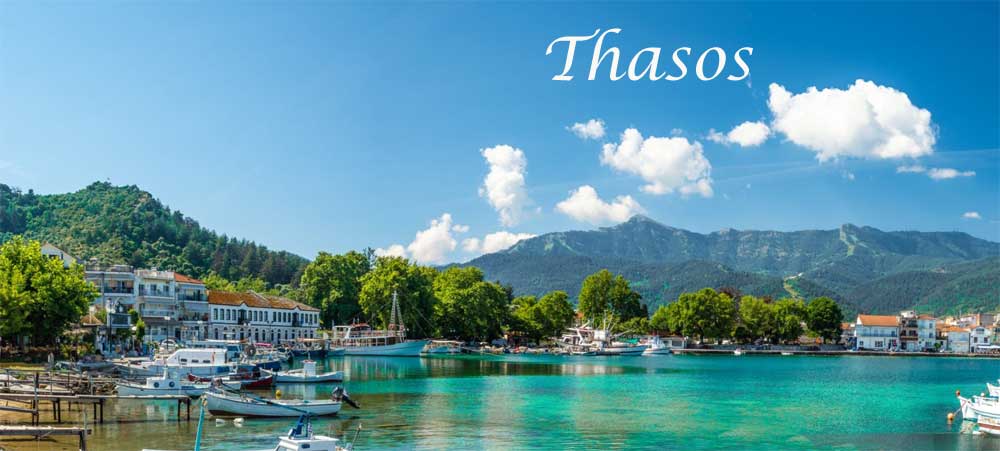Essential information about Thassos island
Thassos is one of the Greek North Eastern Aegean Islands located 10 kilometres south east of the Macedonian port of Kavala. It’s the most northerly of all the Greek islands (except for its small satellite islet of Thasapoula) and has become a popular package holiday destination since the 1990s.
Its wonderful mountain scenery, lushness and fine beaches attract a cosmopolitan collection of summer visitors – Greeks from the mainland, tour groups from Britain and Germany and east Europeans who come by car from Hungary, Romania, Serbia and Bulgaria.
Thassos is an island of abundant natural beauty, rich historical past, and culinary delights that beckon travelers seeking a blend of relaxation and exploration. Known as the “Emerald of the Aegean” for its lush landscapes and the “marble island” for its ancient quarries,
Thassos has always been a place of incomparable natural beauty. It is characterized by its lush vegetation that reaches golden shores, beautiful sunsets, and the quaintness of its mountain villages, all of which together create a picture of unparalleled beauty, tranquility, colours, and aromas.
The island’s fertile plains with their famous olive groves offer a variety of local products and culinary delights in the island’s restaurants and taverns.
The small islets of Thassos are covered with enchanting beaches and excellent fishing spots that complete the island’s magical image. The islet of Astiriotiko in the southwest of Thassos is said to have been the island of the Sirens from the Odyssey or the Lost Atlantis.
Findings from excavations prove that Thassos has been inhabited since the Neolithic Age. In the island’s modern Archaeological Museum, with the giant Kouros at its entrance, the significant exhibits display the island’s rich history. The archaeological monuments in Limenas and Alyki highlight the island’s significant past that dates back centuries.
An island with a rich religious tradition, Thassos has three large monasteries and over 60 churches and chapels. The monastery of Archangel Michael in Potamia, which seems to hover above the sea, and the church of Agia Paraskevi in Theologos, where the icon of the Virgin Mary is made of wax and mastic, are of particular interest.
Beyond its popular tourist resorts and beautiful coastal settlements, Thassos also has picturesque mountain villages amphitheatrically set on the green slopes of Ipsario mountain and surrounded by lush vegetation, overlooking gorges and ravines. They stand out for their traditional Macedonian architecture, old mansions with cobblestone paths, flower-filled courtyards, quaint cafes, and hospitable inhabitants.
Thassos is mountainous and, despite the large and destructive fires of recent years, it remains a place of incomparable natural beauty. It has a rich fauna and flora, with significant ecosystems belonging to the NATURA 2000 areas.
The island is covered with oak forests, olive groves at the foothills, firs at the peak of Ipsario mountain, chestnuts, cedars, plane trees, and pines. Countless rivers, streams, and small waterfalls, green hills and ravines, impressive caves, and lakes compose this unique beauty tableau.
The forested interior is a hikers’ paradise with mountain trails leading through some extraordinarily beautiful natural landscapes adorned with no fewer than 1,250 varieties of wildflowers. You may see the migratory bee-keepers who travel Greece with their bee-hives, settling for periods on Thassos when the appropriate flowers are in bloom.
Visit a local store in one of the island’s many delightful hill villages and you’ll find one 101 things you never thought of doing with honey! The shelves may be stocked with honey and walnut liqueur, prunes in honey, courgettes in honey.
The best way to get the most out of the island is by hiring a car or moped as the entire coastline is skirted by a road which can be negotiated comfortably within a day. Other roads branch off into picturesque mountain settlements where life hardly seems to have changed for centuries despite the best efforts of the tour operators.
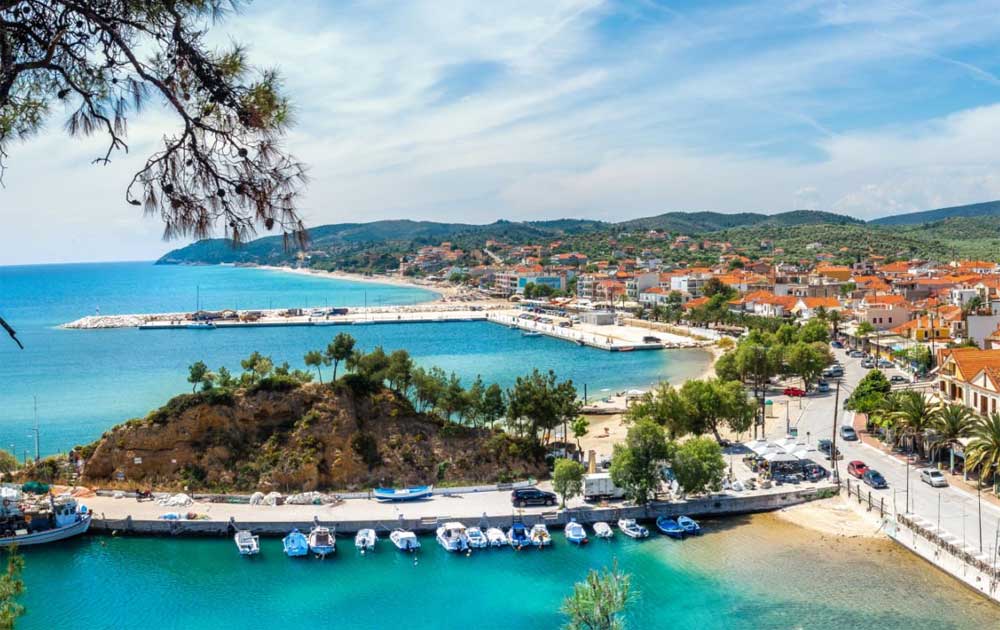
Mythology
Thassos, an island rich in beauty and history, occupies a unique place in Greek heritage. Its story weaves through the threads of myth, ancient civilization, and the strategic interplay of powers across centuries. Here, history and mythology intertwine, painting a vivid picture of the island’s past and its significance in the broader narrative of Greek culture.
According to Greek mythology, Thassos was named after Thasus, the son of the Phoenician king Agenor or, in some versions, the hero from Crete who came in search of his sister Europa after she was abducted by Zeus. Thasus’s journey led him to the island, where he settled and named it after himself. This mythological connection highlights the ancient links between Thassos and the broader Mediterranean world, suggesting early settlement and cultural exchanges.
History
The history of Thassos is inseparable from its identity. From the mythical Thasus to the prosperity of the ancient world and the strategic importance in the Aegean’s historical narrative, Thassos stands as a testament to the enduring legacy of Greek civilization. Its archaeological sites not only attract scholars and tourists but also serve as a bridge to a past where myth and history coalesce, offering endless stories of human endeavor, divine whims, and the natural bounty of the Aegean Sea.
The real historical past of Thassos is as compelling as its mythology. Archaeological evidence points to the island’s habitation from the Neolithic era, but it was the arrival of the Phoenicians, attracted by its gold and silver mines, that marked the beginning of its rich historical saga. Thassos’s wealth in natural resources, including timber, gold, and marble, made it a jewel in the Aegean.
In Limenas (also known as Thassos Town) you can see plenty of evidence of the island’s ancient history in the ruins of the once-great city upon which the present town was built. Thassos has been continuously inhabited since the 7th century BC and was a mighty city state in ancient times thanks to a plentiful supply of valuable natural resources. Gold, ore, timber and marble were exported to Asia Minor, Egypt and Italy bringing huge wealth to the island.
Location and Topography
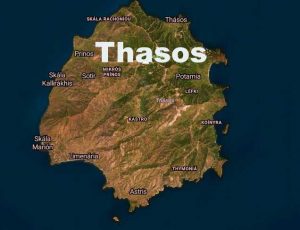
The island covers an area of about 380 square kilometers, making it the 12th largest island in Greece.
The topography of Thassos is predominantly mountainous, with the highest peak, Mount Ipsario, rising to 1,204 meters.
This mountainous landscape contributes to the island’s lush vegetation, as the mountains capture moisture from the air, supporting diverse ecosystems. The interior of Thassos is covered with dense forests of pine, oak, and fir trees, which are among the island’s most striking natural features.
Climate
Thassos enjoys a Mediterranean climate, with mild, wet winters and hot, dry summers. The abundant sunshine and the sea’s moderating influence create an ideal environment for a rich biodiversity and the cultivation of olives, vines, and honey. The climate also supports the island’s lush vegetation, making it a green oasis in the Aegean.
Natural Resources
Thassos is rich in natural resources, which have historically shaped its economy and culture. The island is particularly famous for its white marble, known since antiquity for its purity and brightness. The ancient quarries at Aliki are a testament to the long-standing marble extraction tradition. Additionally, Thassos’s forests have been a source of timber, while its lands are fertile, supporting olive and vine cultivation, contributing to the local gastronomy and economy.
Biodiversity
The diverse habitats of Thassos, from its mountainous areas and forests to coastal ecosystems, host a wide variety of flora and fauna. The island’s intact natural landscapes provide refuge for numerous species of birds, mammals, and insects, some of which are endemic or rare. The marine environment around Thassos is equally rich, with coral formations, fish species, and other marine life thriving in the clean and nutrient-rich waters of the Aegean.
Environmental Conservation
Recognizing the importance of preserving its natural beauty and biodiversity, parts of Thassos are protected under Natura 2000, a network of nature protection areas in the territory of the European Union. These protected areas aim to conserve the island’s unique habitats, species, and landscapes, ensuring that Thassos remains a vibrant and diverse ecosystem.
Best Time to Visit Thassos
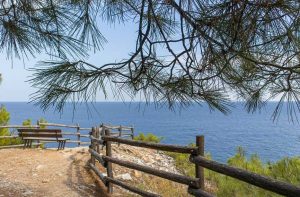
Avoiding the peak tourist season in July and August can help you enjoy a more peaceful experience on this beautiful island. The shoulder seasons of September and October also provide lovely weather for those looking to explore without the crowds.
Keep in mind that winter on Thassos can be quite quiet as many businesses close down during this off-season period. However, if you prefer a more serene atmosphere and don’t mind cooler temperatures, visiting during winter can offer a unique perspective of the island’s natural beauty.
What to Do
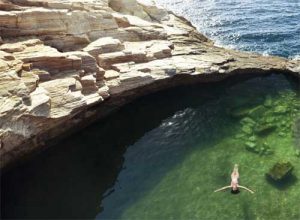
Nature lovers can explore the lush greenery and scenic landscapes by hiking along the numerous trails that crisscross the island. From hidden waterfalls to stunning viewpoints, there’s no shortage of natural beauty to discover.
For those seeking adventure, Thassos provides opportunities for watersports such as snorkeling, diving, and even windsurfing. The crystal-clear waters are perfect for exploring the marine life beneath the surface.
History buffs will appreciate visiting ancient sites like the Archaeological Museum of Thassos or exploring iconic landmarks such as the Ancient Agora. Immerse yourself in centuries-old history while wandering through these well-preserved ruins.
Don’t forget to indulge in some leisurely beach time at one of Thassos’ many picturesque beaches. Whether you prefer secluded coves or lively beach bars, there’s a spot for everyone to relax and soak up the Mediterranean sun.
Entertainment and Nightlife
Thassos, while known for its serene landscapes and rich historical sites, also offers a vibrant entertainment and nightlife scene that caters to a wide range of preferences. As the sun sets over the Aegean, the island transforms, revealing a lively side that complements its daytime tranquility. From quaint tavernas serving local delicacies accompanied by traditional Greek music to modern beach bars where DJs spin the latest hits under the starlit sky, Thassos invites visitors to enjoy its nocturnal charms.
The nightlife in Thassos is diverse, with options ranging from relaxed evenings sipping wine in a seafront café to dancing the night away in one of the island’s clubs or bars. Many establishments are strategically located by the beach, offering the unique experience of night-time festivities by the water. For those seeking a more subdued night out, the island’s villages host a variety of cultural events throughout the summer, including open-air concerts, festivals, and traditional Greek nights that showcase local folk music and dance.
Whether you’re in the mood for a romantic night out, a friendly gathering, or a solo adventure, Thassos’s entertainment scene promises memorable evenings filled with fun, music, and dance. The island’s warm hospitality ensures that every visitor finds their own perfect way to celebrate the night, making Thassos an ideal destination for both relaxation and entertainment.
Towns and Villages
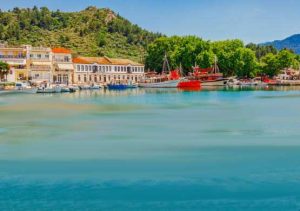
Coastal resorts such as Golden Beach and Skala Potamias boast stunning seaside settings, perfect for those looking to unwind by the Aegean’s crystal-clear waters. Meanwhile, quaint villages like Panagia and Potamia, nestled in the mountains, offer cool retreats and breathtaking views, inviting travelers to delve into a slower pace of life amidst verdant surroundings.
Each village and resort on Thassos tells its own story, set against a backdrop of lush landscapes and historical depth, making the island a mosaic of experiences waiting to be discovered. Whether you’re seeking the vibrant life of seaside resorts or the serene beauty of mountainous hamlets, Thassos provides a perfect blend of relaxation, adventure, and cultural exploration.
Limenas the capital of Thassos
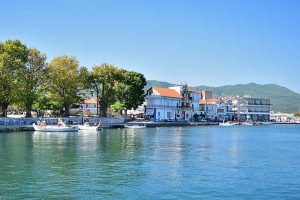
The white houses with tiled roofs dominate the green landscape, while in the port you will find shops and picturesque taverns, hospitable people who will welcome you and serve you.
It is worth visiting the archaeological site and the picturesque mountain villages of the island, built in the green, with traditional Macedonian architecture. The beach is wonderful, with pine trees reaching to the sea and has equipment for water sports.
The most picturesque spot for your afternoon walks is the old port, with its fishing boats and taverns by the sea.
In the summer, don’t miss the ancient drama performances and the concerts organized as part of the Philippi-Thassos Festival and given inside the ancient theater.
Panagia
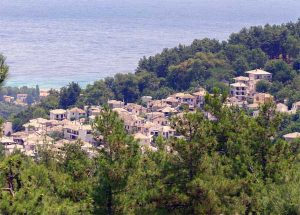
A beautiful mountain village, with a strong Macedonian color, which is 7 km from the center of the island, Limenas, which for a short time, after the Revolution of 21, was the capital of the island.
Built in a verdant area at about 300 meters, with flowing crystal water from the mountain springs, the beautifully made canals in the square of the Three Springs, the cool shade of the century-old plane tree.
It is worth visiting the old church of Panagia and the Drakotrypa cave, named after a stalactite that looks like a dragon. Traditional celebrations of the village are the Carnival, the burning of Judas on Good Friday and the feast of Panagia on August 15.
Its port is Skala Panagias, just 4 km from the village, with the wonderful “Golden Ammoudia” beach, where the fine white sand, the shallow sea and the crystal clear blue-green waters awarded it a blue flag.
Limenaria
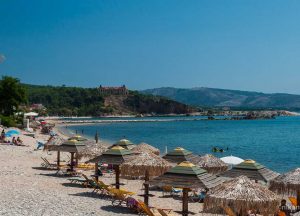
It has a long sandy beach – two kilometers long – with natural shade from the pine trees, which reach all the way to the sea, and a surprise beach to its east, “Metaleia”, where buildings of Bavarian architecture from the last century sprout from the pine forest.
In the village, the neoclassical houses and the ruins of the Venetian castle stand out. The castle comes back to life every January, on the feast of Saint Athanasios – which takes place in the small church with the miraculous icon -, with a traditional festival where a dance is danced-an appeal to the saint for rain.
Limenaria began to develop industrially when the nearby ores were exploited by the German company Speidel between 1905 and 1912, as the mines were rich in deposits of cadmium, a common mineral of zinc.
Potamia
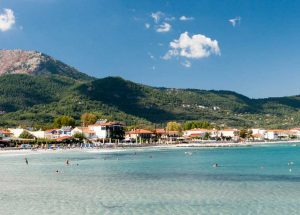
Potamia is located at the base of Mount Ypsario, the highest mountain on the island, with a height of 1,204 meters. For those who want to explore the mountain there is a path from the village all the way to the top, which offers amazing views all day long.
It is worth visiting the Folklore Museum and the churches of Agios Nikolaos and Agios Dimitrios. The tourist traffic is concentrated in Skala Potamias, on the beach of the Golden Coast, where you will find everything you need for a pleasant vacation.
Skala Rachoniou
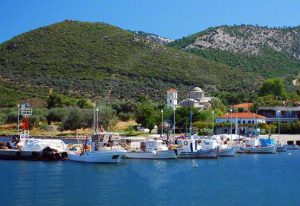
You will relax on the sandy and well-organized beaches, with the natural shade of the pine trees that reach to the sea, while you will gaze at the vast green area and the plain with the olive trees that dominates the area.
Dozens of rural settlements, picturesque taverns and the traditional festivals in Pachoni on August 15th on the feast of the Virgin Mary and on August 20th of the Prophet Elias, will make you feel the familiarity offered by a seaside village combined with the hospitality of its inhabitants.
Potos
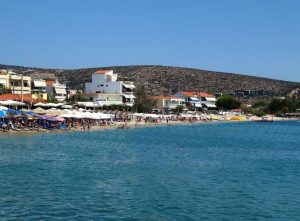
In Alyki are the ancient marble quarries, while on the route between the settlements you will come across the nunnery of Archangel Michael, hanging on the rocks. There is an organized camping site in Potos.
The village of Potos is a cosmopolitan seaside destination on the island of Thassos, which flourishes mainly in the summer months. It is located in the southern part of the island and is popular for its beaches, nightlife and the beautiful atmosphere it offers to visitors.
Potos is ideal for those looking for sunny beaches with crystal clear waters. The central beach of the village is well organized, offering sunbeds, umbrellas and various services that meet the needs of visitors. Around Potos there are also several smaller and quieter beaches, accessible either on foot or by car.
Prinos
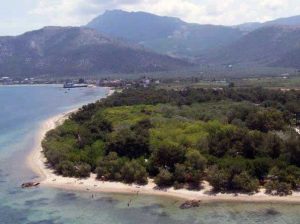
Its location is “strategic” as it is in the middle of the Limenas – Limenaria route, while it also has the only health center on the island. It consists of Neos Prinos and the picturesque mountain villages Mikros and Megalos Prinos.
You must visit Skala Prinos, with sandy and waveless beaches, shallow and crystal clear waters, suitable for swimming and water sports. In fact, two beaches in the area have been awarded the Blue Flag. The green pine forest along the beach creates a magical image, with the pine trees appearing to emerge from the water. In Skala Pinou, it is worth visiting the small shipyard, next to the port, where small and medium-sized ships are built.
Beaches
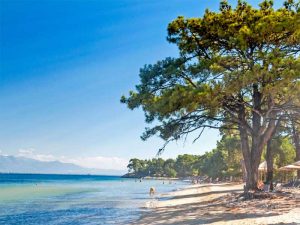
The island’s natural landscape provides a stunning backdrop to its beaches, with pine trees often stretching down to the water’s edge, offering shade and adding to the idyllic scenery. Whether you’re seeking adventure, relaxation, or simply a slice of paradise, Thassos’ beaches promise unforgettable moments against the backdrop of the sparkling Aegean Sea.
Their unspoiled beauty not only captivates those who visit but also tells the tale of an island rich in history and culture, where the azure of the sea meets the green of the forests in perfect harmony.
Thassos is dotted with a mix of sandy and pebble beaches, secluded bays, and natural harbors. The island’s beaches are renowned for their crystal-clear waters, ranging from deep blue to turquoise, and fine sands or colorful pebbles. Some of the most famous beaches include Golden Beach, Paradise Beach, and Aliki Beach, each offering unique natural settings and recreational opportunities.
Traditional Cuisine and Dining Options
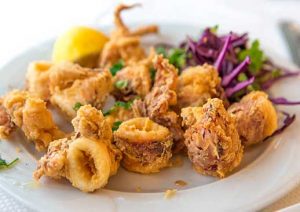
Apart from seafood, don’t miss out on trying local specialties such as thyme honey, olive oil, and feta cheese – all produced locally on the island. Pair your meal with a glass of retsina or tsipouro for an authentic taste of Greece.
When dining out in Thassos, explore quaint tavernas by the sea or charming family-run restaurants nestled in hidden corners of the island. Embrace the relaxed atmosphere and warm hospitality that accompanies each meal – it’s not just about what you eat but also where you eat it that makes dining in Thassos so special.
Where to Stay
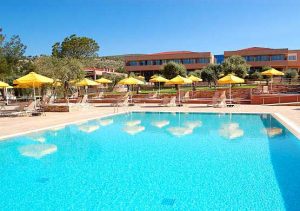
For travelers seeking a more immersive experience, there are charming boutique hotels that offer personalized service and unique decor reflecting the island’s culture. If you prefer a more independent stay, consider renting a traditional stone house or villa for added privacy and flexibility during your visit.
Camping enthusiasts will also appreciate the campgrounds scattered around the island, providing an opportunity to connect with nature while still enjoying modern amenities. No matter where you choose to stay on Thassos, rest assured that Greek hospitality will make your accommodation experience truly memorable
Moving around Thassos
Exploring Thassos offers an array of experiences, from its stunning beaches and historical sites to its mountainous landscapes and charming villages. Moving around Thassos efficiently is key to experiencing all that the island has to offer. Here are some tips and options for getting around Thassos to help you plan your visit.
By Car or Motorcycle
Renting a car or motorcycle is one of the most flexible and popular ways to explore Thassos. The island has a main ring road that circles around it, connecting all major villages, beaches, and points of interest. This road, along with smaller offshoots leading to various attractions, is generally in good condition. Renting a vehicle allows you to travel at your own pace, make spontaneous stops, and access more remote areas that might be difficult to reach by public transport.
By Bus
Thassos has a reliable public bus service that connects the capital, Limenas (Thassos Town), with most major villages, beaches, and tourist spots. The buses run frequently during the summer months, providing an economical and convenient way to travel, especially along the main coastal areas. Schedules and routes can be found at the bus stations and online, allowing you to plan your journeys accordingly.
By Taxi
Taxis are available throughout Thassos and offer a convenient, albeit more expensive, alternative to buses. They can be hailed on the street or booked in advance. Taxis are particularly useful for direct transfers, such as from the port to your accommodation or for reaching destinations not covered by the bus network. Agreeing on the fare in advance or ensuring the meter is running is advisable to avoid surprises.
By Bicycle
For the more adventurous and those who enjoy active holidays, cycling can be a rewarding way to see Thassos. The island’s varied terrain, with its coastal paths and mountain trails, makes it suitable for both leisurely rides and more challenging expeditions. Bike rentals are available in several locations, offering daily or weekly hire. However, remember that summer temperatures can be high, so plan accordingly to avoid the midday heat.
Walking and Hiking
Thassos is a hiker’s paradise, crisscrossed with trails that meander through ancient olive groves, dense forests, and over scenic hillsides. Walking is perhaps the best way to appreciate the island’s natural beauty up close. From leisurely strolls along the beaches to more strenuous hikes up Mount Ipsario, the island’s highest peak, there are options for all levels of fitness and interest. Maps and guides for hiking trails are available at tourist information centers.
Boat Trips
Exploring Thassos by sea offers a different perspective on the island’s beauty. Several operators offer boat trips around Thassos, including stops at secluded beaches, swimming and snorkeling in crystal-clear waters, and the opportunity to see the island from the water. These tours can be a relaxing way to spend a day and are a great option for experiencing Thassos’s coastal splendor.
Insider Tips for a Perfect Trip to Thassos
When visiting Thassos, be sure to explore beyond the main tourist spots. Venture off the beaten path to discover hidden gems and authentic local experiences. Renting a car is highly recommended to access remote beaches and picturesque villages that might not be easily reachable by public transportation.
To avoid crowds, consider visiting Thassos in the shoulder seasons of spring or fall when the weather is still pleasant but with fewer tourists around. Don’t miss out on trying traditional Greek dishes at family-run tavernas for an authentic culinary experience.
Pack comfortable shoes for exploring the island’s hiking trails and ancient ruins, like the archaeological site of Ancient Agora or the Monastery of Archangel Michael. And remember to always carry cash as some smaller establishments may not accept card payments.
Immerse yourself in Thasian culture by attending local festivals and events if your trip coincides with them. Don’t forget your sunscreen and hat as you soak up the sun on Thassos’ beautiful beaches!
Getting there
Getting to Thassos, the northernmost of the Greek Aegean islands, involves a combination of overland and sea travel due to its close proximity to the mainland. Whether you’re starting your journey from within Greece or coming from abroad, there are several routes to consider, each offering its own advantages.
By Air
While Thassos itself doesn’t have an airport, the nearest airports are located on the mainland in Kavala (Kavala International Airport “Alexander the Great”, KVA) and Thessaloniki (Thessaloniki Airport “Makedonia”, SKG).
From Kavala: Kavala Airport is the closer of the two, situated about 30 minutes from Keramoti, where you can catch a ferry directly to Thassos (Limenas). During the summer months, there are frequent ferry connections that accommodate the increase in tourists.
From Thessaloniki: Thessaloniki Airport, while further away, offers more flight options, including international flights. From Thessaloniki, you can travel by bus, rental car, or taxi to Keramoti or Kavala to catch a ferry to Thassos. The journey by road from Thessaloniki to Keramoti takes approximately 2-3 hours, depending on traffic and conditions.
By Road
Traveling to Thassos by car is a popular option for visitors, especially those coming from other parts of Greece or neighboring countries. The road network in Northern Greece is well-developed, making for a comfortable drive.
From Kavala: Once in Kavala, you can take a ferry from the port of Kavala to Skala Prinou or Limenas on Thassos. The ferry ride from Kavala to Thassos takes about 75 minutes to Limenas and slightly less to Skala Prinou.
From Keramoti: The port of Keramoti offers the shortest and most frequent ferry crossings to Thassos (Limenas), with the journey taking about 35 minutes. This route is especially convenient if you’re coming from Kavala Airport or from the east.
By Ferry
For those already in Greece or traveling through the Greek islands, ferries and boats are an integral part of the country’s transport network.
Ferry Services: Regular ferry services connect Thassos with the mainland, making several trips daily during the peak tourist season. The two main entry points on Thassos are Limenas (Thassos Town), the capital of the island, and Skala Prinou. Tickets can be purchased at the port or in advance through various travel agencies and online platforms.
